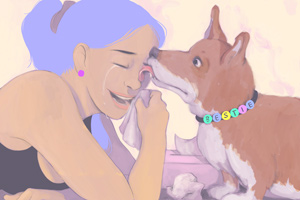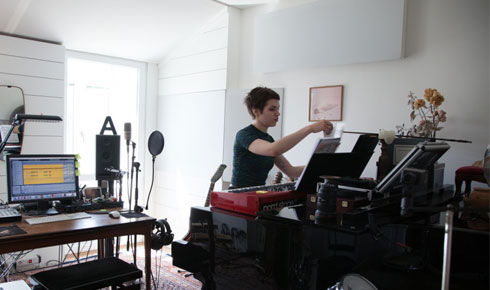Translated by @pixelrust and @donasonica
Vuoi leggerlo in italiano? Clicca qui.
I dove into electronic music 4 years ago, after spending my adolescence exploring the lands of post-rock, metal, hardcore, post-punk, post-anything.
Multiple times, I had tried joining bands as a singer, but nothing ever actually came out of that. Sometimes the reason was that all the bands I knew were wary of having a girl in the band, but more often, the reason was I’ve always liked better to play solo.
So I recently bought a mic, taught myself Ableton Live and gave life to my musical project.
As I began, though, I found myself wondering:
1) the number of female producers I can look up to for inspiration is so low. Why?
2) almost all producers I’m friends with are male. Why?
I want to answer these questions, but even more I want to change this hard reality.
In this article, I will often use the term “electronic music”, but the specific scene I’m actually referring to is the “club culture” one (house, techno, bass music) because — as Funerals’ Mollie Wells says — for female producers things change from scene to scene:
People tend to think of electronic music as this monolithic whole, but there’s a vast difference between scenes. The dudes I know making minimal synth would never tell you it’s a masculine place. But, if I’m being honest, techno sometimes is. There’s a compulsory masculinity in that world, the assumption that if you’re making something club-centric, you must be a dude.
As far as I can see, there are two problems: 1) an undeniable low involvement of women and — as a consequence — 2) low visibility for the few ones who do get involved in the scene. Viceversa, low visibility for women leads to a predominantly male vision of club culture.
So it doesn’t matter much which came first between the chicken and the egg: the problem is we’re trapped in a vicious cycle that needs to be broken.
First of all, the inadequate acknowledgement of female contribution — in the fields of art, science, literature — is a systemic problem. Thus, I’m not saying anything new when I tell you how female pioneers of acoustic and electronic research have been sadly forgotten. Let’s remember Wendy Carlos (trans woman who helped building the synthesizer, and published the first album in which she demonstrated its use), Clara Rockmore, Delia Derbyshire, Daphne Oram and many others.
Erasing women from the history that gets written down after their death leads to two deadly effects: it maintains a male-centered vision of technology development and it deprives posterity (actually, us posterity-girls) of charismatic leading examples.
Having only few female examples to follow doesn’t help girls and young women to be comfortable and self-confident when they get into those activities which are still considered — wrongly — a male domain.
It’s exactly because their contribution to the area is — and has been — ignored by most people that women in the scene are still seen as something exceptional, and not as part of a production that goes beyond genres.
Mollie Wells again:
“Woman” is not a genre. Stop acting like we’re a passing fad. Delia Derbyshire, Daphne Oram, Wendy Carlos, Doris Norton, Suzanne Ciani, Cynthia Webster… even Goldfrapp and Add N To (X)’s Ann Shenton. These women weren’t on the periphery of electronic music…they pioneered it.
That’s right: let’s stop acting like that. If only we included women in the basic history of electronic music, if we remembered about their work, structural impediments to female participation would start disappearing as well.
Madeleine Bloom, Berliner producer who worked at Ableton live technical support, illustrates how all this had a strong impact on her career. When she was hired, Bloom learnt two things right away: she was the very first woman giving tech support there and very few women were calling her.
Later she also found out that only 7% Ableton’s users were women. This was in 2010 or 2011. She wasn’t expecting big numbers, but that 7% was pretty shocking to her.
According to Madeleine, audio softwares are still mainly used by men due to lots of stereotypes about women, music and tech, and we definitely need to start rejecting them.
When I started doing phone support shifts I was shocked by how often I was either mistaken for a secretary or how some insisted to speak to someone else when they heard a woman’s voice on the other end.
Putting aside those useless, foolish prejudices, which are unworthy of discussion, Bloom thinks that what drives men – and not women – towards music is social status.
When I meet a guy who plays guitar, I always ask when he started. ‘As a teenager?’ ‘Yes.’ ‘To appear cool and impress the girls?’ Generally, I get a yes as well, if somewhat more reluctant. No woman I talked to got started with music for these reasons though. Why? Because girls who make music are rather seen as kooky and boys don’t find them more rad. There’s simply no incentive there. There are also less role models to aspire to. Girls rarely get into music to reach a certain social status.
If we want to see more girls behind a console, everyone has to do their part wisely.
First, as clearly stated in the documentary Ride the Balance, we have to encourage young girls to get into music, to express themselves and trust their own skills.
In the case of dance music: “[we need to start]introducing girls to audio softwares labs before they get into the phase when they start believing they will never have the skills needed”, says australian producer Anna Lunoe. We have to make sure that, regardless of gender, being a producer looks attractive and achievable.
Then we need to change how club culture works now: as researcher Jennyfer M. Brown explained in her amazing work (published in 1996 but still very relevant), “most women tackle their learning of technology in isolation or by ranging the fringes of male activity, rather than by forming solidarity groups and setting up cooperative learning situations with peers”¹ which create then a movement capable of evolving and breaking fiercely into the core of the scene.
Sure, tutorials can be useful for using Ableton, but there’s nothing like learning and evolving with friends. My friends share previews of their new works all the time, asking for advice, getting together to work. We girls would be doing the same, creating a network, a sort of nerd version of riot grrrls: to support, cooperate and learn from each others.
Lastly, it’s essential that specialized media, blogs, organizers, labels, pretty much all clubbing industry, become aware of its basic role in shaping the way the scene looks like and take responsibility for female producers’ visibility and representation.
There’s still so much work to do, and in the hope of meeting many other digital riot grrls soon, it’s time to roll up your sleeves, stretch those fingers and go back to Ableton. See you on soundcloud!
¹Brown, JM 1996, ‘De-gendering the electronic soundscape: women, power and technology in contemporary music’, Masters thesis, Southern Cross University, Lismore, NSW.










Nessun commento